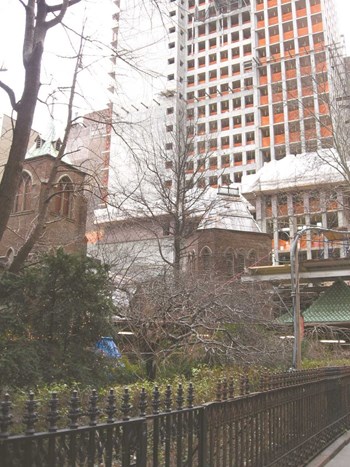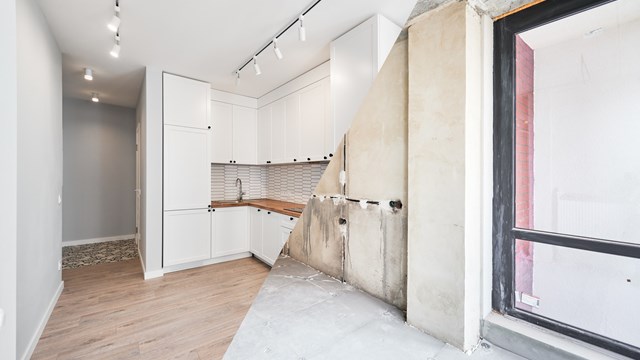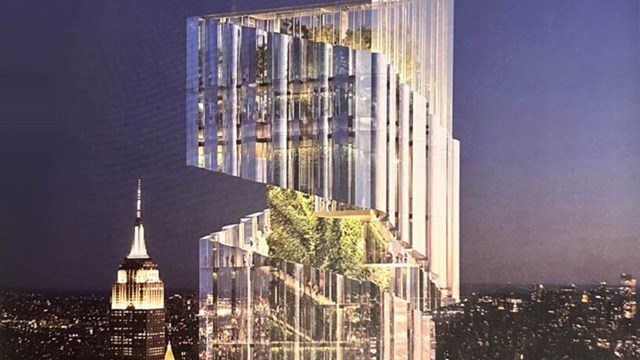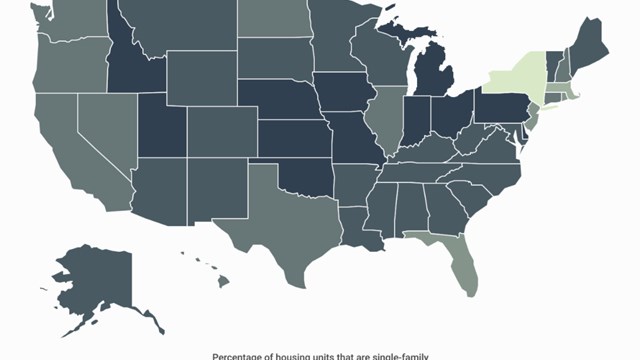
It’s no secret—in fact, it’s been a problem for years: residential developers in Manhattan and other hot areas like Downtown Brooklyn are running out of space.
Various solutions have been applied to the space issue over the years. When the tenements in Lower Manhattan became too crowded to bear and the invention of the elevator enabled architects to design upward, the city went vertical in addition to spreading outward. In the 1970s and 80s, the solution was to convert old industrial buildings into residential and studio space for artists—a trend that continues to this day. Another, even more modern idea has been to purchase “air rights” from existing buildings in order to build ever upward in historically low-rise neighborhoods. As it turns out, among the parties who are most interested in selling their air rights are religious institutions.
Air What?
What are air rights—or development rights, as they’re also known? In a particular zoning district, each piece of property is allowed to build up to a certain height. Various areas around the city have different allowable building heights.
According to Carl Doebley of DPK&A Architects based in Manhattan and Philadelphia, “air rights and air right transfers become important when, for instance, a developer who owns a property zoned for 10 stories, say, believes he can get more value out of his property.”
Through an air rights transfer, that developer can then purchase the air rights—the right to build to a certain height—from a property next to or across from his. He can then add the additional height represented by those air rights to the height he would normally be allowed, and thus build a much taller building.
Air rights transfers are most often used in areas where a developer wants to build a high-rise in an area surrounded by low-rise buildings. For example, the developers of the high-rise apartment building at 180 Montague Street in Brooklyn Heights, constructed in 2000, were able to build up to 33 stories by purchasing air rights from surrounding buildings.
As long as there are two adjacent properties, a developer can purchase air rights from an adjacent building as of right, says attorney Bob Davis of Bryan Cave LLP in Manhattan. At some point, the city must be notified by putting a record in the office of the city register or the county clerk, but the developer doesn’t need the city’s approval. (Of course, in a landmark district, other rules come in to play.)
Air rights are sold at cost per square-foot. For example, says Manhattan architect and planner Raymond Plumey, “In Manhattan, they are in the range of $400 to $600 per square-foot of potential development rights.”
Well Suited
One group of buildings that seems particularly suited to the idea of selling air rights to developers in order to raise funds are houses of worship—churches, synagogues and mosques. Religious institutions are often short of cash, and because many of them are landmarks, they can’t build upward. Even for those that aren’t designated historic landmarks, the design of a typical church makes adding on inconvenient and expensive, if not flat-out impossible.
Selling valuable air rights to a well-funded developer would seemingly be a boon to both the church, which gets more revenue for its programs and for building repair, as well as the developer, who gets to build a taller building and have more units to sell. After all, the goal of a church or synagogue is usually not to improve its real estate, but to provide worship services, community outreach, and charitable programs.
A recent, much publicized example of a church partnering with a residential developer is the historic Episcopal Church of the Transfiguration on East 29th Street—better known as the “Little Church Around the Corner.” The church demolished its parish house and sold its air rights to a developer whose 55-story luxury condo—called the Sky House— built on the parish-house site will reportedly net about $7 million for the congregation. The Sky House condo will contain 139 residences, a 24-hour doorman, concierge services, a state-of-the-art fitness center and a children’s playroom.
And on the north side of 42nd Street between Eighth and Ninth Avenues, the Ivy Tower has risen, built with church and school air rights purchased from the Church of the Holy Cross, which once was home to Father Francis Duffy, spiritual adviser to Broadway in the 1920s.
“Churches are generally under-funded,” says the Rev. Gerald Keucher, chief of finance and operations for the Episcopal Diocese of New York, “so the money is attractive. In the old days, in the early 19th and early 20th centuries, churches often relocated as new neighborhoods were developed, and their parishioners moved. Nowadays, there is no new land to develop, and the church often finds itself the steward of a landmark property”—a property that can cost quite a bit to maintain.
The New York Landmarks Conservancy, a group dedicated to preserving historic building in New York, sponsors the Sacred Sites program, which provides financial and technical assistance for the maintenance, repair, and restoration of religious properties throughout the state. Recognizing the financial bind that churches find themselves in, Sacred Sites doesn’t object as such to them selling their air rights to developers, as long as the resulting development is appropriate and tasteful. Other churches taking advantage of this development boom include the Episcopal Cathedral of St. John Divine, 401 East 110th Street; St. John Nepomucene Parish, 411 East 66th Street; and the Islamic Cultural Center of New York, a mosque at 215 East 96th Street.
One problem that the Sacred Sites program does see, according to its director, Ann-Isabel Friedman, happens when religious institutions don’t have enough experience to properly weigh the developers’ offers. “Developers are calling on these properties, knowing that they may not be the most sophisticated real estate partners,” she says. That’s one of the reasons why the program provides them with technical and real estate advice, and refers them to architects, engineers and contractors.
The Aesthetic Issue
Of course, once the church, synagogue or mosque sells its air rights to a developer, you then have a tall building next door. Does this present a problem from an aesthetic standpoint? Opinions vary.
Davis, for example, says that New York City is known for having a wide variety of building heights—for example, a tall glass building next to a three-story brownstone building—and most people don’t find it a problem. Similarly, Rev. Keucher adds that “I would like to think that [the new high-rise] brings several hundred or so new parishioners.”
However, Plumey, the architect and planner, disagrees. “Having high-rise buildings break the pattern of existing low- to mid-rise building destroys the fabric and context of a well-planned city,” he says.
“Preservationists and civic groups are not pleased with the proliferation of high-rise buildings in their low- to mid-rise neighborhoods or historic districts,” he adds. These new high-rise buildings tend to destroy a neighborhood scale and quality of life.”
Plumey is a board member of CIVITAS, an organization that seeks to promote, preserve and preserve the residential communities of the Upper East Side and East Harlem. Its mission including having “limits on overbearing residential towers.”
One recent example of community opposition to a high-rise development project by a religious institution concerns not a church, synagogue or mosque—but a seminary. The General Theological Seminary, which occupies the entire block between Ninth and Tenth avenues, 20th and 21st streets in Chelsea, has about 240,000 square feet of unused air-rights on its property.
A recent plan would have left its historic 19th century buildings alone, but would have torn down a five-story, 1960s-era building and built in its stead a 17-story, mixed-use tower. Protests from area residents forced them to go back to the drawing board and revise the original plan.
While she isn’t opposed to churches and synagogues raising income from redevelopment per se, Friedman of Sacred Sites is critical of deals that completely overwhelm the original church or synagogue. For example, a project that tears down the original church or synagogue building and replaces it with ground floor or basement space in a tower. This, she believes, “eliminates the building’s ‘street’ identity and character.”
One example she gives goes back to the 1920s, when Second Presbyterian Church at Central Park West and 96th Street was damaged during the construction of the IND subway. The congregation replaced the church building with a very attractive residential tower (now itself a designated landmark), but if you walk by, you don’t realize that a church and school are inside.
Financially-strapped houses of worship often are less concerned about the impact of having tall buildings next door. “Any time a deal comes up, there will be people who are opposed to it, but you deal with it as part of the politics of how people get along,” says Rev. Keucher.
Non-Financial Benefits
At times, the religious institutions even manage to gain non-financial benefits from a development rights deal. For example, in some cases the developer might give the church, synagogue or mosque an office in the new building, or space for a new social program, or free use of meeting rooms.
In one rather spectacular example, the current site of the Citicorp Tower was once occupied by St. Peter’s Lutheran Church, known for its jazz concerts and ministry to jazz musicians. When Citicorp purchased the church’s land and its air rights in the 1970s, it erected the tower—but also built a new, modernistic church building for the congregation at its base.
“It’s all on the table,” says Doebley. “I’ve seen horse trading for parking spots.”
In the last analysis, the strategy by developers of buying air rights from churches and other institutions is only one way dealing with the situation of great demand for housing, but an increasingly small amount of land.
Davis points to two innovative strategies being used by the city administration.
In the area near the High Line—the former elevated freight railway in Chelsea that is now being converted to a park—the city has given height easements to builders who will contribute to the High Line, either with financial contributions or actual work and equipment for the project. Similarly, in the Theater District, the city has let legitimate theaters sell air rights to developers who wish to build in areas within a few blocks, not just next door or across the street.
As long as churches, synagogues and mosques have trouble raising enough cash to pay their clergy, to sponsor educational, religious and social programs, and to maintain their often-deteriorated buildings—and as long as developers are eager build high-rises—air rights deals between the two will likely remain an attractive option. Raanan Geberer is a freelance writer living in New York City.






Leave a Comment